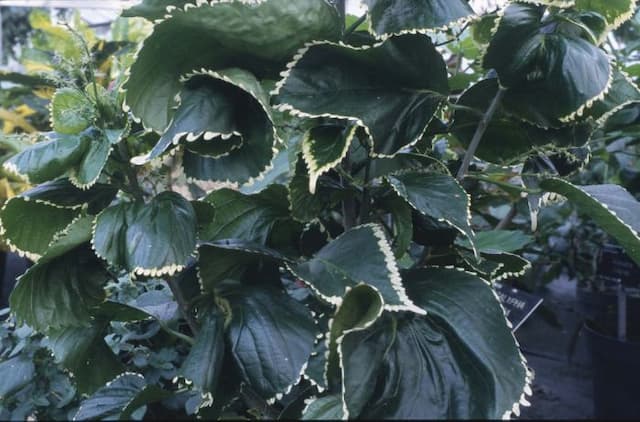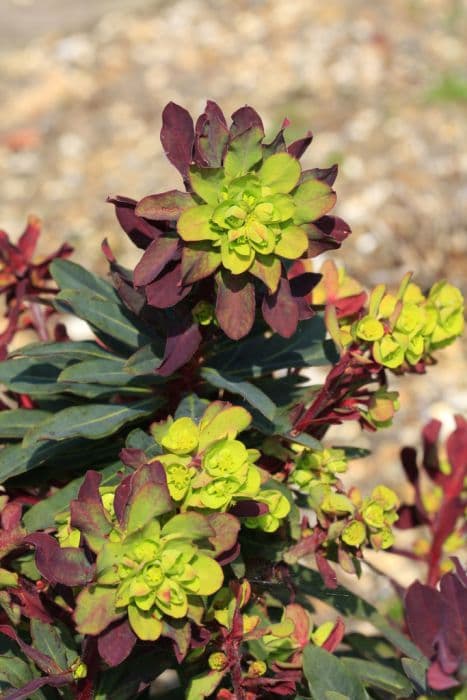Mediterranean Spurge Euphorbia characias 'Blue Wonder'

ABOUT
Euphorbia characias 'Blue Wonder' is a perennial plant renowned for its eye-catching appearance. It features an upright growth habit with multiple stems that bear dense, cylindrical clusters of small flowers. The flowers are notable for their distinct two-part structure, comprising tiny, actual flowers surrounded by colorful, petal-like bracts. These bracts are typically a bluish-green hue, giving the plant a unique and striking coloration that sets 'Blue Wonder' apart from other varieties. The foliage of 'Blue Wonder' consists of slender, elongated leaves that spiral around the stems. These leaves possess a bluish or grayish-green color, further adding to the plant's cool-toned color scheme. The leaves are often overlooked due to the prominence of the colorful bracts and flowers. During its flowering season, the plant becomes a focal point in the garden due to its vibrant and unusual floral display. The combination of the blue bracts and the actual flowers, which can appear in a contrasting color, creates a bold visual effect. While the physical dimensions of 'Blue Wonder' are not the focus of this description, it is worth noting that the overall form of the plant is typically rounded and dense, forming a substantial presence in the landscape without referring to the specific size measurements. Overall, this Mediterranean native adds a touch of drama and an unconventional color palette to gardens with its striking blue-green appearance.
About this plant
 Names
NamesFamily
Euphorbiaceae
Synonyms
Mediterranean Spurge, Albanian Spurge, Wulfen's Spurge
Common names
Euphorbia characias 'Blue Wonder'.
 Toxicity
ToxicityTo humans
Euphorbia, commonly known as Spurge, is toxic to humans. All parts of the Spurge plant contain a white, milky sap known as latex that can cause skin irritation and inflammation upon contact. If the sap gets into the eyes, it can lead to severe eye irritation and possibly temporary blindness. Ingesting Euphorbia can cause irritation to the mouth and throat, stomach pain, vomiting, and diarrhea. More severe symptoms may include allergic reactions, shortness of breath, or swallowing difficulties. It is crucial to handle Euphorbia with care and to wash hands immediately after contact to prevent accidental ingestion or rubbing the eyes, which could result in serious consequences.
To pets
Euphorbia, also known as Spurge, is toxic to pets. The white, milky sap contained in all parts of the Spurge plant can be harmful if ingested. In pets, consumption of Euphorbia may lead to symptoms such as vomiting, diarrhea, drooling, or loss of appetite. Additionally, if the sap comes into contact with your pet’s skin, it may cause irritation, redness, swelling, and in severe cases, chemical burns. If the toxic sap contacts the eyes, it can cause conjunctivitis or more serious eye injuries that could lead to blindness. It is important to keep Euphorbia out of reach of pets and to seek veterinary care immediately if you suspect your pet has ingested or come into contact with the plant.
 Characteristics
CharacteristicsLife cycle
Perennials
Foliage type
Evergreen
Color of leaves
Blue-green
Flower color
Yellow-green
Height
3 feet [0.91 meters]
Spread
2 feet [0.61 meters]
Plant type
Shrub
Hardiness zones
8
Native area
Mediterranean
Benefits
 General Benefits
General Benefits- Drought Tolerance - Once established, it has a good resistance to periods of low watering, making it suitable for xeriscaping and drought-prone areas.
- Long Blooming Season - Offers an extended period of visual interest with its chartreuse-yellow flowers, typically from early spring to summer.
- Deer Resistance - The plant's milky sap and texture tend to deter deer, making it an excellent choice for gardens in areas with high deer populations.
- Low Maintenance - Requires minimal care once established, aside from occasional pruning to maintain shape and encourage new growth.
- Architectural Shape - Adds structural interest to garden designs with its upright, columnar growth habit.
- Attracts Pollinators - Flowers can attract beneficial insects such as bees and butterflies.
- Mediterranean Origin - Well-suited to gardens that mimic the Mediterranean environment or for coastal landscapes.
- Striking Foliage - Blue-green leaves provide a unique color contrast to other plants in the garden.
- Versatile Garden Use - Can be used as a standalone specimen, in borders, or in container gardens.
- Erosion Control - Its root system can help stabilize soil on slopes and banks, reducing erosion.
 Medical Properties
Medical PropertiesThis plant is not used for medical purposes.
 Air-purifying Qualities
Air-purifying QualitiesThis plant is not specifically known for air purifying qualities.
 Other Uses
Other Uses- Euphorbia 'Blue Wonder' can be used as a natural pest deterrent in gardens due to its toxic sap which is off-putting to many pests.
- Its unique structure and color can be utilized in floral art, providing an interesting texture and hue to compositions.
- The sap of Euphorbia 'Blue Wonder' has been traditionally used as a fish poison in some cultures to temporarily stun fish for easier collection.
- It can serve as a protective barrier around more sensitive garden plants due to its unappealing sap to herbivores.
- In photography, Euphorbia 'Blue Wonder' is especially photogenic due to its architectural form and can be used as a subject in botanical photography.
- It can be used in educational settings to teach about plant defense mechanisms, given its unique toxic properties and protection strategy.
- Euphorbia 'Blue Wonder' is often used in xeriscaping, a landscaping method that reduces or eliminates the need for supplemental water from irrigation.
- Some artists use the latex from Euphorbia 'Blue Wonder' in mixed-media artwork as a textural element.
- The plant can act as a soil erosion control mechanism due to its robust root structure in suitable climates.
- Gardeners may use Euphorbia 'Blue Wonder' to provide winter interest in gardens, as it has evergreen qualities and remains visually appealing throughout the season.
Interesting Facts
 Feng Shui
Feng ShuiThe Euphorbia is not used in Feng Shui practice.
 Zodiac Sign Compitability
Zodiac Sign CompitabilityThe Euphorbia is not used in astrology practice.
 Plant Symbolism
Plant Symbolism- Endurance: Euphorbia plants, in general, are known for their resilience and the ability to thrive in challenging conditions, symbolizing stamina and persistence.
- Protection: With its toxic sap and spikey form, euphorbias are often associated with defense and protection against negative forces.
- Purification: Some cultures believe that euphorbias have the power to cleanse the air and the environment of bad energy, symbolizing purity and renewal.
 Water
WaterMediterranean Spurge, including the 'Blue Wonder' variety, should be watered deeply but infrequently, as it prefers well-drained soil and does not tolerate overwatering. Establish plants normally require watering once every 1-2 weeks during their active growth in spring and summer, with a reduction to once a month or less during winter dormancy. When watering, apply approximately 1-2 gallons of water to the base of the plant, allowing the soil to dry out completely between watering sessions. Overwatering can lead to root rot which is a common issue with this drought-tolerant plant.
 Light
LightMediterranean Spurge thrives in full sun conditions where it can receive at least six hours of direct sunlight a day. The best spot for 'Blue Wonder' is a location that offers bright, unfiltered sunlight to promote healthy growth and optimal foliage coloration. Partial shade is also tolerable, but too much shade can lead to leggy growth and fewer flowers.
 Temperature
TemperatureMediterranean Spurge 'Blue Wonder' is hardy and adapts to a wide range of temperature conditions. It can tolerate temperatures as low as 20 degrees Fahrenheit but prefers a range between 50 and 70 degrees Fahrenheit for ideal growth. Extreme heat above 90 degrees Fahrenheit may stress the plant, although it is quite heat tolerant once established.
 Pruning
PruningPruning Mediterranean Spurge 'Blue Wonder' is often done to maintain shape, remove spent flowers, and promote vigorous growth. Pruning should be done in late winter or early spring before new growth begins. Cut back the stem to the ground every couple of years to rejuvenate the plant. Always wear gloves when pruning as the sap can be an irritant.
 Cleaning
CleaningAs needed
 Soil
SoilThe Mediterranean Spurge 'Blue Wonder' requires well-drained soil with a pH range between 6.0 to 7.5. A mix of loamy soil with added perlite or sand can enhance drainage. Organic content such as compost can be beneficial, but over-rich soil should be avoided to prevent leggy growth.
 Repotting
RepottingThe Mediterranean Spurge 'Blue Wonder' should be repotted every 2-3 years to refresh the soil and accommodate root growth. It's best to repot in spring before the growing season starts.
 Humidity & Misting
Humidity & MistingThe Mediterranean Spurge 'Blue Wonder' prefers a dry to average humidity environment. It is tolerant of low humidity levels and does not require high humidity to thrive.
 Suitable locations
Suitable locationsIndoor
Place in bright indirect light with good airflow.
Outdoor
Plant in full sun to partial shade in well-draining soil.
Hardiness zone
7-10 USDA
 Life cycle
Life cycleMediterranean Spurge 'Blue Wonder' begins its life as a seed, which germinates in warm soil typically in late spring or early summer. Following germination, the seedling establishes itself, developing a strong root system and foliage. As the plant matures, it forms an upright bushy shrub with narrow blue-green leaves, and by the second or third year, it begins to produce characteristic inflorescences with small actual flowers surrounded by showy, yellowish-green bracts in late winter to early spring. After pollination, typically by insects, the plant sets seed which is distributed by explosive dehiscence when the fruit capsules mature and dry. The parent plant may die back after seeding, particularly if it's a short-lived perennial or biennial form, but it often survives to flower in subsequent years, repeating this reproductive cycle. Meanwhile, fallen seeds will potentially sprout and produce new plants, continuing the species lifecycle.
 Propogation
PropogationPropogation time
Spring-Early Summer
The Mediterranean Spurge 'Blue Wonder', or Euphorbia characias 'Blue Wonder', is most commonly propagated through seed sowing. The optimal time for sowing seeds is in the spring, after the risk of frost has passed. To propagate by seeds, you should start by collecting the seeds from the spent flower heads once they have dried. Sow the seeds shallowly in a well-draining seed-starting mix and cover them lightly with soil. The pots should then be placed in a warm, bright location but out of direct sunlight. Keep the soil moist but not waterlogged. Germination can take anywhere from 1 to 4 weeks. Once seedlings have developed true leaves and are large enough to handle, they can be transplanted into individual pots or into the garden at a spacing of about 18 inches (approximately 45 centimeters) apart to allow for growth.



![Spurge [Blackbird]](/_next/image?url=https%3A%2F%2Fplants-admin.emdemapps.com%2Fimages%2Fplants%2F%2Fimages%2F604b535f37783.png&w=640&q=75)





